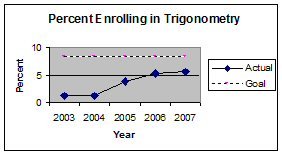- About MAA
- Membership
- MAA Publications
- Periodicals
- Blogs
- MAA Book Series
- MAA Press (an imprint of the AMS)
- MAA Notes
- MAA Reviews
- Mathematical Communication
- Information for Libraries
- Author Resources
- Advertise with MAA
- Meetings
- Competitions
- Programs
- Communities
- MAA Sections
- SIGMAA
- MAA Connect
- Students
- MAA Awards
- Awards Booklets
- Writing Awards
- Teaching Awards
- Service Awards
- Research Awards
- Lecture Awards
- Putnam Competition Individual and Team Winners
- D. E. Shaw Group AMC 8 Awards & Certificates
- Maryam Mirzakhani AMC 10 A Awards & Certificates
- Two Sigma AMC 10 B Awards & Certificates
- Jane Street AMC 12 A Awards & Certificates
- Akamai AMC 12 B Awards & Certificates
- High School Teachers
- News
You are here
The Unique Effects of Including History in College Algebra - Findings (1)
Over the last three years at BHSU, great strides have been made in improving student outcomes in College Algebra with the inclusion of history in the course. The same results theorized by many (Bruckheimer & Arcavi, 2000; Heiede, 1996; Johnson, 1994; Kleiner, 1996; Man-Keung, 2000; Rickey, 1996; Smith, 1996; Swetz, 2000) about the effects of inclusion of the historical development of concepts in mathematics courses can now be seen in the College Algebra course.
Figure 1 shows the changes in the percentage of students enrolled in the fall College Algebra course who continued on to enroll in Trigonometry. The dotted line shows the goal of 8%. The solid line shows the growth in the percentage of the students enrolling in Trigonometry. The number of students enrolled in College Algebra in the fall has consistently remained around 360 students. The number enrolling in Trigonometry has grown from 5 students in 2003 and 2004 to 20 students in 2007.

Figure 1. Percent of students enrolling in Trigonometry from 2003-2007
The increase started in 2005, the year the history modules were introduced. Besides quadrupling the number of students enrolling in Trigonometry, average student achievement in Trigonometry also increased by approximately 6-7%, from about a 70% overall average to an overall average of 76-77% for the course. Furthermore, the Trigonometry instructor reports that this class has doubled in size, attendance has increased, there is an improved success rate and a greater percentage of students are making their way to Calculus. In the coming semesters, as more students who were exposed to the revised College Algebra course matriculate into Calculus, increased enrollment and achievement is expected in Calculus.
There has been significant improvement on test problems where mathematical vocabulary and notation have created difficulty for students in the past. One example is that when students were asked to find the inverse function of \(f(x)=\frac{x+2}{2-x},\) students would pick the reciprocal about 30% of the time prior to the use of history in the College Algebra course. After the introduction of history to the course, students are picking the reciprocal only about 15% of the time.
D. Goodwin (Black Hills State University) and G. W. Hagerty (Black Hills State University) and S. Smith (Black Hills State University), "The Unique Effects of Including History in College Algebra - Findings (1)," Convergence (June 2010), DOI:10.4169/loci002530




